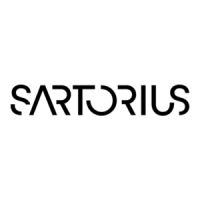Do you have a question about the Sartorius ED2201 and is the answer not in the manual?
General safety instructions for equipment use and handling.
Safety precautions to be observed during the installation process.
Safety precautions and steps for connecting the balance/scale to AC power.
Purpose and procedure for leveling the balance/scale.
Identification of the balance/scale's display and operating controls.
Explanation of the functions of keys and symbols used.
A step-by-step guide demonstrating a simple weighing process.
Definition and objectives of calibration and adjustment procedures.
Process for performing automatic internal calibration.
Explanation of key operations within the configuration menu.
Determining the number of parts based on their approximate equal weight.
Adjusting the reference sample quantity for counting.
A detailed procedural example for counting parts.
Obtaining weight readouts as percentages relative to a reference weight.
Adjusting the reference value for percentage calculations.
A step-by-step example for determining residual weight in percent.
Calculating weight per unit area or gsm using multipliers/divisors.
Procedure for inputting numerical factors or divisors.
A step-by-step example for calculating weight per unit area of paper.
Averaging weights of unstable samples using subweighing operations.
Setting the desired number of measurements for averaging.
A step-by-step example for automatic animal weighing.
Weighing multiple components into a defined total.
Storing component weights and clearing the memory.
A step-by-step example for counting parts into a container.
Adding successive independent weight values to exceed capacity.
Storing up to 99 values and toggling between values.
A step-by-step example for totalizing weight values.
Changing the displayed weight value to different units.
A step-by-step example for converting between weight units.
Determining density of solids using the buoyancy method.
A step-by-step example for determining the density of a solid sample.
Information included in the GLP header and footer.
Setting menu codes for ISO/GLP-compliant printouts.
Table listing common issues, their causes, and recommended solutions.
Steps for cleaning the balance/scale housing and stainless steel surfaces.
General safety instructions for equipment use and handling.
Safety precautions to be observed during the installation process.
Safety precautions and steps for connecting the balance/scale to AC power.
Purpose and procedure for leveling the balance/scale.
Identification of the balance/scale's display and operating controls.
Explanation of the functions of keys and symbols used.
A step-by-step guide demonstrating a simple weighing process.
Definition and objectives of calibration and adjustment procedures.
Process for performing automatic internal calibration.
Explanation of key operations within the configuration menu.
Determining the number of parts based on their approximate equal weight.
Adjusting the reference sample quantity for counting.
A detailed procedural example for counting parts.
Obtaining weight readouts as percentages relative to a reference weight.
Adjusting the reference value for percentage calculations.
A step-by-step example for determining residual weight in percent.
Calculating weight per unit area or gsm using multipliers/divisors.
Procedure for inputting numerical factors or divisors.
A step-by-step example for calculating weight per unit area of paper.
Averaging weights of unstable samples using subweighing operations.
Setting the desired number of measurements for averaging.
A step-by-step example for automatic animal weighing.
Weighing multiple components into a defined total.
Storing component weights and clearing the memory.
A step-by-step example for counting parts into a container.
Adding successive independent weight values to exceed capacity.
Storing up to 99 values and toggling between values.
A step-by-step example for totalizing weight values.
Changing the displayed weight value to different units.
A step-by-step example for converting between weight units.
Determining density of solids using the buoyancy method.
A step-by-step example for determining the density of a solid sample.
Information included in the GLP header and footer.
Setting menu codes for ISO/GLP-compliant printouts.
Table listing common issues, their causes, and recommended solutions.
Steps for cleaning the balance/scale housing and stainless steel surfaces.
| Capacity | 2200 g |
|---|---|
| Readability | 0.01 g |
| Repeatability | 0.01 g |
| Display | LCD |
| Stabilization Time | 1.5 s |
| Calibration | External |
| Operating Temperature | 10 °C to 40 °C |
| Interface | RS-232 |












